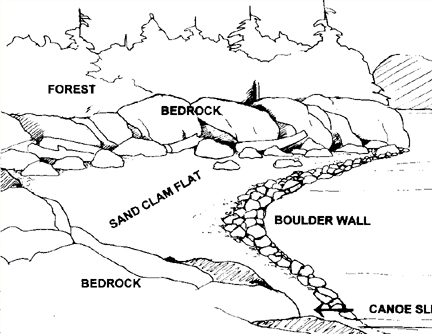Clam Gardens
Williams, Judith. Clam Gardens: Aboriginal Mariculture On Canada’s West Coast. 2006. New Star Books LTD
Pre-Contact West Coast indigenous peoples are commonly categorized in anthropological literature as “hunter gatherers”. However, new evidence suggests they cultivated bivalves in stone-walled foreshore structures called “clam gardens” which were only accessible at the lowest of tides. Judith Williams journeyed by boat around Desolation Sound, Cortes and Quadra Islands and north to the Broughton Archipelago to document the existence of these clam gardens. The result is a fascinating book that bids to change the way we think about West Coast aboriginal culture. — from the back cover
Clam Gardens is a delightful little book, written by an artist and resident of the British Columbian archipelago. A native friend told her about the clam gardens, she investigated them, and “re-discovered” a complex maritime aquaculture of great antiquity. After years of study and pestering of university anthropologists, Judith Williams finally convinced them that the vast network of coastal clam beds from Puget Sound to the Queen Charlotte Islands were largely anthropogenic.
Native people had not only dug natural clam habitat, but, in favourable locations around the Broughton islands, had erected a complex of rock-walled terraces that suggest what we call mariculture.
Bringing these Native mariculture structures to light may be termed, by some, a “discovery,” although the clam gardens, as will be shown, were never lost. Given the evidence of Native knowledge and usage that has also come to light, it’s prudent to sidestep that term. Let’s just say that the story of the re-emergence of these rock structures makes visible to the non-Native world a mindset-altering number of boulder walls, which were erected by Northwest Coast indigenous people at the lowest level of the tide to foster butter clam production. The number of gardens, their long usage, and the labour involved in rock wall construction indicate that individual and clustered clam gardens were one of the foundation blocks of Native economy for specific coastal peoples.

———————————————————————————————-
The Northwest Coast Indians did not need convincing, since they had been building, maintaining, and utilizing the clam gardens for thousands of years. The cultivated landscapes of native North America were not confined to dry land, as Clam Gardens so enjoyably reveals.
